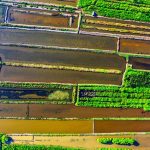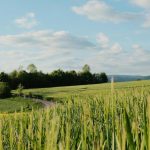A geotextile retaining wall works by using strong fabric layers to reinforce and stabilize soil, preventing erosion and landslides. You place geotextiles that filter water, allow drainage, and hold soil particles together, creating a durable composite structure. Anchors and fill material support the wall, while the fabric distributes loads evenly and stops soil shifting. This method suits unstable soils and slopes. If you want to understand its materials, installation, and benefits better, there’s more to explore.
Table of Contents
Key Takeaways
- Geotextile retaining walls stabilize soil by reinforcing it with specialized fabric that prevents soil shifting and erosion.
- The fabric acts as a barrier, allowing water to pass while holding soil particles in place, improving drainage and reducing pressure.
- Layers of geotextile are anchored and combined with fill material to create a strong composite structure that supports soil loads.
- Drainage systems integrated with geotextiles prevent water buildup behind the wall, enhancing stability and preventing failure.
- This design blends naturally into the environment, providing effective erosion control and slope stabilization without rigid concrete structures.
Definition and Purpose of Geotextile Retaining Walls
Geotextile retaining walls use specialized fabric to stabilize soil and prevent erosion. When you install one, you’re fundamentally reinforcing the soil behind the wall to stop it from shifting or sliding.
This fabric acts like a strong barrier, allowing water to pass through while holding soil particles in place, which reduces pressure on the wall itself. You’ll find these walls useful in areas prone to landslides or where the soil is loose and unstable.
By integrating the geotextile into the wall’s structure, you improve its durability and lifespan. Plus, these walls help control drainage, preventing water buildup that could weaken the soil.
Types of Geotextile Materials Used
Although selecting the right material might seem overwhelming, knowing the main types of fabrics used in retaining walls can simplify your decision. You’ll mainly encounter woven, non-woven, and knitted geotextiles. Each offers unique benefits depending on your project’s needs.
| Type | Description | Common Use |
|---|---|---|
| Woven | Made by weaving fibers | High strength, drainage |
| Non-woven | Needle-punched fibers | Filtration, separation |
| Knitted | Interlocking loops of fibers | Flexibility, reinforcement |
Understanding these types helps you pick the best fabric that provides durability, drainage, and soil stability for your retaining wall, ensuring a long-lasting structure.
How Geotextiles Interact With Soil
You’ll see geotextiles play a key role by reinforcing soil and improving stability.
They also help filter water while draining excess moisture to protect the structure.
Understanding how soil sticks to and interacts with these materials is essential for effective wall design.
Soil Reinforcement Mechanisms
When soil interacts with geotextiles, it gains added strength and stability that traditional retaining walls can’t provide on their own.
You’ll find that geotextiles reinforce soil by distributing loads more evenly and restricting soil particle movement. This happens because the fabric’s tensile strength supports the soil mass, preventing it from shifting or settling excessively.
As you place geotextile layers within the soil, they act like internal belts, holding soil together under pressure. This reinforcement reduces lateral earth pressures on the wall, allowing for steeper, more stable slopes.
By integrating geotextiles, you create a composite structure where the soil and fabric work as a system, improving overall durability and performance of the retaining wall.
This synergy is key to effective soil stabilization.
Filtration and Drainage Functions
Beyond reinforcing soil, geotextiles play an essential role in managing water within retaining wall systems. They act as filters and drainage facilitators, preventing soil particles from clogging drainage paths while allowing water to flow through. This balance helps maintain wall stability and reduce hydrostatic pressure.
Here’s how they work:
- Filter soil particles: Geotextiles trap fine soil, stopping it from washing away.
- Allow water passage: They let water drain through, preventing buildup behind the wall.
- Reduce pore water pressure: By draining excess water, they lower pressure that could destabilize the wall.
- Prevent soil erosion: Filtering soil while directing water protects the integrity of the soil structure.
Soil-Geotextile Adhesion
Three key factors determine how well geotextiles adhere to soil, directly affecting the strength and stability of retaining walls.
First, the texture of the geotextile matters; rough or needle-punched fabrics increase friction, helping the soil grip better.
Second, soil type plays an essential role—cohesive soils like clay cling more effectively to geotextiles than sandy soils, which may slip.
Third, soil moisture content influences adhesion; optimum moisture allows soil particles to settle firmly against the fabric, enhancing contact.
When you choose a geotextile, consider these factors to guarantee proper interaction with your soil.
This adhesion helps distribute loads evenly, prevents soil movement, and keeps the retaining wall intact under pressure, ultimately boosting the wall’s performance and lifespan.
Structural Components of a Geotextile Retaining Wall
You’ll find that the geotextile material plays a key role in reinforcing the soil and providing stability.
Alongside it, wall support elements work together to hold everything in place under pressure.
Understanding these components helps you see how the entire system stays strong and secure.
Geotextile Material Functions
Geotextile materials play an essential role in the structural integrity of retaining walls by providing reinforcement, filtration, and drainage functions. When you use geotextiles, you enhance soil stability and prevent erosion efficiently.
Here’s how these materials function:
- Reinforcement: They strengthen the soil by distributing loads and increasing tensile strength, helping the wall resist pressure.
- Filtration: Geotextiles allow water to pass while blocking fine soil particles, preventing soil loss behind the wall.
- Drainage: They facilitate water flow away from the soil, reducing hydrostatic pressure that could damage the structure.
- Separation: Geotextiles keep different soil layers apart, preserving soil integrity and preventing mixing.
Wall Support Elements
A retaining wall relies on several key support elements to maintain its strength and stability. When you build or inspect a geotextile retaining wall, you’ll notice these components work together to hold back soil effectively.
| Element | Purpose | Material Type |
|---|---|---|
| Facing | Retains soil visually | Concrete, stone, geotextile |
| Geotextile Layers | Reinforce soil, distribute load | Synthetic fibers |
| Drainage System | Prevents water buildup | Gravel, perforated pipes |
| Backfill | Supports and stabilizes wall | Compacted soil |
| Anchors | Secure geotextile layers | Steel rods or strips |
Installation Process and Techniques
Although the installation process may seem complex at first, understanding each step will help you build a durable geotextile retaining wall with confidence.
Start by preparing the site: clear debris and level the ground to guarantee a stable base.
Next, lay the geotextile fabric carefully, securing it to prevent displacement.
Then, begin placing the fill material in layers, making sure to compact each layer thoroughly to enhance stability.
Finally, anchor the geotextile fabric behind the wall by wrapping it into the fill, creating a reinforced soil mass that supports the structure.
Follow these steps:
- Site preparation and leveling
- Geotextile fabric placement and securing
- Layered fill placement and compaction
- Anchoring fabric into the soil
Stick to this process, and your retaining wall will stand strong.
Advantages Over Traditional Retaining Walls
When you compare these retaining walls to traditional ones, you’ll find they offer several distinct benefits.
First, geotextile retaining walls are more flexible, adapting better to ground movements and reducing the risk of cracking or failure. They’re also lighter, making transportation and installation easier and faster, especially in hard-to-reach areas.
You’ll appreciate their cost-effectiveness since they often require less material and labor. Plus, they improve drainage by allowing water to pass through, which reduces hydrostatic pressure behind the wall, enhancing stability.
Unlike rigid concrete walls, geotextile walls blend more naturally with the environment, offering aesthetic advantages.
Common Applications in Landscape and Civil Engineering
Since geotextile retaining walls offer flexibility and durability, they’re widely used in both landscape design and civil engineering projects.
You’ll find them especially useful when tackling challenging soil conditions or tight spaces.
Here are four common applications you might consider:
- Slope stabilization: Prevent erosion and landslides on steep terrain.
- Roadway support: Reinforce embankments along highways and railways.
- Garden landscaping: Create terraced levels or raised beds with clean, natural aesthetics.
- Water management: Build retaining walls that control runoff and protect against flooding.
Maintenance and Longevity of Geotextile Walls
Because geotextile retaining walls rely on both synthetic fabrics and proper installation, you need to perform regular inspections and maintenance to assure they last.
Check for signs of fabric damage, erosion, or soil displacement, especially after heavy rains or freezes. Clear debris and vegetation that could compromise the fabric or drainage system.
Ascertain drainage remains unobstructed to prevent water buildup, which can weaken the structure. If you notice any tears or exposed geotextile layers, address them promptly to avoid further deterioration.
Properly maintained geotextile walls can last several decades, providing durable support. Staying proactive with maintenance not only extends your wall’s lifespan but also preserves its structural integrity, saving you costly repairs or replacements down the line.
Environmental Impact and Sustainability Benefits
Although geotextile retaining walls serve a practical purpose, they also offer significant environmental benefits that you mightn’t expect.
When you choose these walls, you’re helping the environment in several ways:
- They reduce the need for heavy construction materials, lowering carbon emissions.
- Their permeability allows natural water flow, preventing erosion and promoting groundwater recharge.
- Using recycled geotextile fabrics can minimize landfill waste.
- They support vegetation growth on slopes, enhancing local biodiversity and stabilizing soil naturally.
Frequently Asked Questions
Can Geotextile Retaining Walls Withstand Earthquakes?
You can rely on geotextile retaining walls to withstand earthquakes well, as they provide flexibility and reinforcement. They absorb seismic forces, reducing damage risk. Proper design and installation are key to ensuring their earthquake resistance.
What Is the Typical Cost Comparison to Concrete Walls?
You’ll find geotextile retaining walls typically cost less than concrete walls. They require less material and labor, making them budget-friendly while still providing strong support and durability for your landscaping or structural needs.
Are Geotextile Walls Suitable for Coastal Erosion Control?
Imagine your beach towel holding sand against waves—that’s geotextile walls controlling coastal erosion. You’ll find they’re flexible, durable, and eco-friendly, making them a smart choice to protect shorelines from relentless water damage.
How Do Geotextile Walls Handle Heavy Rainfall Drainage?
You’ll find geotextile walls let water pass through while holding soil back, so during heavy rainfall, they prevent water buildup and reduce pressure. This drainage helps keep the wall stable and avoids erosion or failure.
Can Plants Be Integrated Into Geotextile Retaining Walls?
Yes, you can integrate plants into geotextile retaining walls. They help stabilize soil, reduce erosion, and improve aesthetics. Just choose suitable vegetation that thrives in your wall’s environment and supports its structural integrity.
- Does Chiffon Fabric Stink - July 15, 2025
- Does Chiffon Fabric Affect the Economy - July 15, 2025
- Does Cotton Fabric Have a Nap - July 15, 2025







